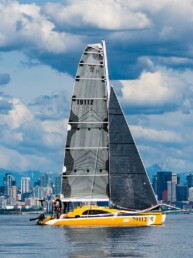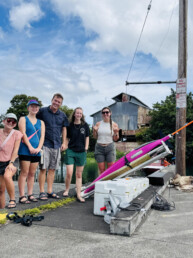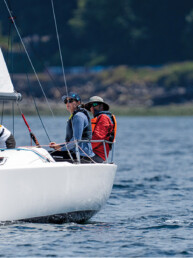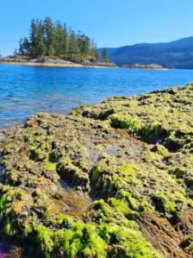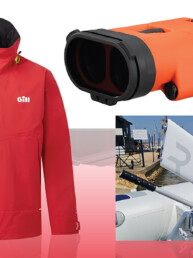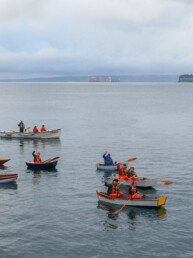This article originally appeared in the May 2021 issue of 48° North.
There’s only one way to start this. Deep breath. To my knowledge, this is the first powerboat review that 48° North has ever done. Stay with me…
I often save opinions such as these for the end of a boat test article, but it feels important to share this right up front. I think the Aspen C100 is stinkin’ cool. Moreover, the whole design concept is sophisticated, and the construction is modern and uncompromising. That Aspen Power Catamarans are built in Washington state by a family-run business founded by the guy who came up with the big idea — well it doesn’t get much more
perfectly PNW.
To understand the Aspen C100, you’ve got to understand Aspen’s innovations, and to do that, you’ve got to know founder and designer, Larry Graf. Larry is an innovator, but not in that crazy cackling genius way. Touring the factory, he confidently strode from building to building describing every tiny detail of the design and construction. Who says you can’t be an expert
on everything?
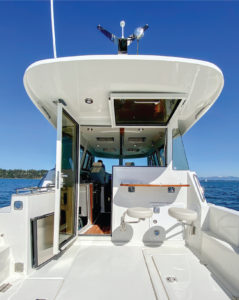 After building and selling a different Northwest power cat business, Larry zeroed in on the revelation that would really put his boats on the map and started Aspen in 2008. It seems simple in retrospect, especially for historically informed sailors. With two hulls, you only need an engine in one of them (a second adds weight and appendage drag). Consequently, you can reduce the required size and buoyancy — and thus the weight and drag — of the engineless hull by about one-third. Neat! We’ve got ourselves a proa. But wait, put the propulsion unit in the starboard quarter of a rectangular platform and surely the boat will turn to port under power. Larry’s got an answer for that as well. By designing the hull form in an asymmetric wing shape, it is possible to offset the forces created by the auxiliary with a hull shape that would naturally turn the boat to starboard. The result: it tracks straight.
After building and selling a different Northwest power cat business, Larry zeroed in on the revelation that would really put his boats on the map and started Aspen in 2008. It seems simple in retrospect, especially for historically informed sailors. With two hulls, you only need an engine in one of them (a second adds weight and appendage drag). Consequently, you can reduce the required size and buoyancy — and thus the weight and drag — of the engineless hull by about one-third. Neat! We’ve got ourselves a proa. But wait, put the propulsion unit in the starboard quarter of a rectangular platform and surely the boat will turn to port under power. Larry’s got an answer for that as well. By designing the hull form in an asymmetric wing shape, it is possible to offset the forces created by the auxiliary with a hull shape that would naturally turn the boat to starboard. The result: it tracks straight.
The boats are built to exacting standards. Larry proudly showed me the bonus incentives his boat building staff can achieve with benchmarks not just for time, but for quality. It’s clear that the decisions in construction were not made by the finance department. With delight and minute particulars, Larry unveiled his Aspen composite system, noting several times along the way which materials were more expensive, but worth it. From the gelcoat to the foam, the woven roving to the kevlar in the bow — quality materials precede careful craftsmanship. It’s a part of the sales pitch, of course, but Larry’s own C100 came off the truck on the highway, hit a concrete median, and the boat won. I’d say they’re built like a brick sh*thouse, but brick would be way too heavy.
In all of this, Larry was committed to efficiency. He sought to minimize weight and drag, and maximize a strong design with smart construction and a sea kindly motion thanks to wave piercing hulls, while delivering power and fuel economy.
So that’s why I think the C100 is a great first powerboat to explore in the pages of 48° North. This is sailor-level design and construction geekery, utilizing a hull concept that ancient sailors pioneered. And, this is a cruising boat — inboard diesel, king size berth, a standard solar package, with impressive seaworthiness and range for its size — that can take you well into the wild. All of this taps into something very common among sailors: we want to feel the freedom to adventure in remote places, and we want a boat that can handle conditions worse than we humans actually want to expose ourselves to.
Well, after taking the C100 out for a spin on a summery April afternoon, I’d say it hits those marks in spades, and you might have to call me a Kool-Aid sipper. So, what is this particular boat all about?
The C100 is not one of Aspen’s newest designs. In fact, it was the second design they started producing back in 2013. It remains, however, a staple in their line, and for good reason.
The C100 is an accessible and versatile size. At 32 feet (34′ 8″
overall with the substantial swim platform), it has some big boat feel — it was very comfortable powering through wind chop and wake. It has big boat amenities like a bow thruster and windlass; and it provides comfortable cruising accommodations for a couple or a small family both indoors and out, including the aforementioned king size forward berth.
Meanwhile, everything about the boat feels manageable. Its 10-foot beam makes it reasonably trailerable, and it doesn’t need an extra-wide slip. Its dry weight is 9,300 pounds, it draws less than 3 feet, and its propeller is protected by a skeg. Not that you ever want to hit a log or, worse, a rock… but if you were going to do it, this might be a boat that can withstand it.
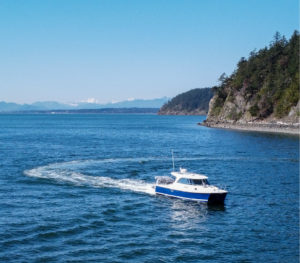 The cockpit is spacious, open, and malleable. It has simple and functional seating, like hinging stools under the coachroof and a cooler seat along the aft coaming. I imagine cruisers would add some other collapsible furniture. For families interested in fishing, this cockpit would be terrific and, indeed, a locker to store your catch can be found under the cockpit sole.
The cockpit is spacious, open, and malleable. It has simple and functional seating, like hinging stools under the coachroof and a cooler seat along the aft coaming. I imagine cruisers would add some other collapsible furniture. For families interested in fishing, this cockpit would be terrific and, indeed, a locker to store your catch can be found under the cockpit sole.
Like so many sailing catamarans, the Aspen C100 accomplishes a seamless flow between the cockpit and interior living space. In addition to the door between the two, the new C100s have a hinging window panel to starboard of the door. When they’re both open, the salon has a decidedly open-air feel.
The salon itself is simple and elegant — the galley with lots of clever storage is to port, balanced by the dinette to starboard. The helm and controls are forward. Follow the stairs to starboard from there to find the forward berth and the enclosed wet head.
Under another of those cockpit sole lockers, you find the 220 horsepower Volvo Penta D3. Between the engine’s power and the design’s low weight and hydrodynamic efficiency, the Volvo provides plenty of juice for cruising at a variety of speeds. Care was taken to soundproof the engine compartment as much as possible, and this really matters. I wondered how much louder the engine noise would be with the salon door and back window open (how you’d want it during the prime cruising season) versus closed. Surprisingly, cruising at about 15 knots and just over 3,000 rpm, the decibel meter indicated 76 decibels with door and window closed and only 79 when they were open. For context, our speaking voices were pushing into the low 80s on to that meter. This is to say that, for all of its power, the engine is quiet.
I was very impressed by the performance. The boat climbed to speeds in the high teens smoothly and effortlessly, and didn’t have the jarring motion I’ve known in some speedy powerboats. It felt very stiff. It was simple to drive, and the helm was responsive to adjustment. When pressed into a turn at higher speeds, the C100 felt rock-solid stable. More importantly, it did what the asymmetric design brief prescribes: it tracked straight with no input from the helm.
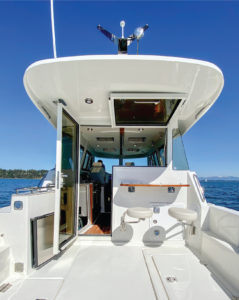 Ok, so the thing can go fast, but power cruisers know that fuel efficiency is every bit as important. We experimented with different speed settings. Here’s the gist: for maximum fuel economy, you still should stay in a more typical trawler speed range, around 7 knots. Here, Aspen’s performance tests indicate you might get 6.9 miles per gallon, and a very efficient gallon-per-hour equilibrium. What’s more notable though, and borne out on our test day, is that the fuel efficiency plateaus when cruising between 10 and 16 knots, there isn’t much of a penalty with fuel usage in that range, and it’s all around 3 miles per gallon. In other words, why not go 16? At these speeds and with the standard 80-gallon fuel tank, the boat has a range of about 225 miles. A larger 120-gallon tank is an available upgrade, and this would increase the range to 350 miles.
Ok, so the thing can go fast, but power cruisers know that fuel efficiency is every bit as important. We experimented with different speed settings. Here’s the gist: for maximum fuel economy, you still should stay in a more typical trawler speed range, around 7 knots. Here, Aspen’s performance tests indicate you might get 6.9 miles per gallon, and a very efficient gallon-per-hour equilibrium. What’s more notable though, and borne out on our test day, is that the fuel efficiency plateaus when cruising between 10 and 16 knots, there isn’t much of a penalty with fuel usage in that range, and it’s all around 3 miles per gallon. In other words, why not go 16? At these speeds and with the standard 80-gallon fuel tank, the boat has a range of about 225 miles. A larger 120-gallon tank is an available upgrade, and this would increase the range to 350 miles.
To paint a real-life picture: in 2014, Larry circumnavigated Vancouver Island in a C100, nonstop without refueling (he employed jerry cans and ultimately burned 267 gallons). He took 47 hours and 5 minutes to complete the 557-mile route. That’s really key to me. This is a boat that can go places — yes, quickly — in efficient comfort and style.
Cruising the Pacific Northwest, Inside Passage, and Alaska is just about the best thing you can do — whether you travel under sail or power. If power is your choice, the Aspen C100 would be among the best options to live thatcruising dream.
Joe Cline
Joe Cline has been the Managing Editor of 48° North since 2014. From his career to his volunteer leadership in the marine industry, from racing sailboats large and small to his discovery of Pacific Northwest cruising —Joe is as sail-smitten as they come. Joe and his wife, Kaylin, have welcomed a couple of beautiful kiddos in the last few years, and he is enjoying fatherhood while still finding time to make a little music and even occasionally go sailing.

